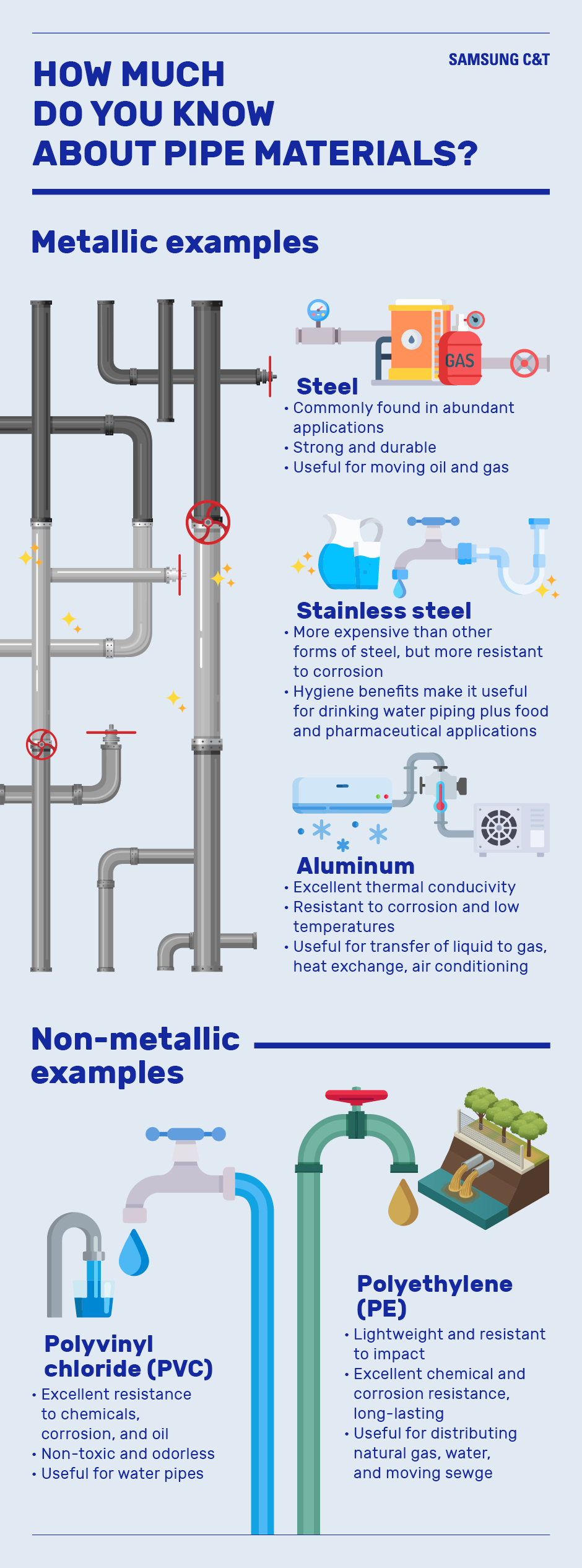At a glance
- The development of various materials has allowed pipes to become stronger and more resistant to pressure, extreme temperatures, and corrosion
- Samsung C&T trades several materials that are used to make pipes
- Steel and stainless steel are good examples of materials that have transformed the world of pipes all around us
Having looked at copper and its many amazing properties in our last “Getting to know” article, we recall that one of copper’s applications is pipes for plumbing and other water systems.
Well, this prompted us to wonder about the world of pipes all around us moving liquids, gases, and even solids. They can be found in homes, offices, factories, and underground. And they are also made of various metallic and non-metallic materials.
But not just any material can be used to make pipes, which need to have particular characteristics depending on what is flowing inside them. In this latest article, we’ll aim to get to know pipe materials – and you might recognize some of them from Samsung C&T Trading & Investment Group’s business activities.
From an ancient solution to modern pipelines
As numerous materials have been discovered and developed over time, people have been able to apply them to pipes. For example, ancient civilizations developed pipes using bamboo, clay, and copper. With the development of modern metals and plastics, the whole concept and system of pipes has been transformed to allow us to transport more diverse commodities over increasingly ambitious distances. Think of America’s Colonial Pipeline, which can move gasoline or jet fuel from Texas to New York!
The reason why “modern metals and plastics” have played such an important role is that they have allowed pipes to become tougher and more resistant to factors such as high pressure, extreme temperatures, and corrosion.
The development of steel pipes from 1815, for instance, paved the way for energy companies to move oil and gas by pipeline. Today, steel pipes are used for abundant applications that rely on their strength and durability. With the innovation of stainless steel, pipes have been applied to settings that prioritize hygiene and corrosion resistance – these include moving water for drinking as well as uses in the food and pharmaceutical industries.
Another metal used for pipes is aluminum, which is much less dense than steel, but its excellent thermal conductivity along with low-temperature and corrosion resistance make it an appropriate choice of material for transferring liquid to gas, heat exchanges, and air conditioning.
It is also possible to use lighter, non-metal pipe materials. While they will not be as strong as their metal counterparts, they are often prized for their additional corrosion resistance, which can be helpful when moving most kinds of chemicals, water, and sewage. Examples include polyvinyl chloride (PVC) and polyethylene (PE), as shown by the infographic below.
Where does Samsung C&T come in?
Samsung C&T trades a variety of materials essential for pipe manufacturing, including metals such as steel and stainless steel, as well as non-metallic materials.
Of course, these materials also have many other applications. We also previously got to know stainless steel, which is popular in a range of industries for many of the same reasons that it is useful as a pipe material.
As a trading company, it is important to always consider the optimal way of moving commodities around the world. It also helps if you can contribute to the supply of materials that are actually used to keep pipes working, whether over a few meters or thousands of kilometers!










